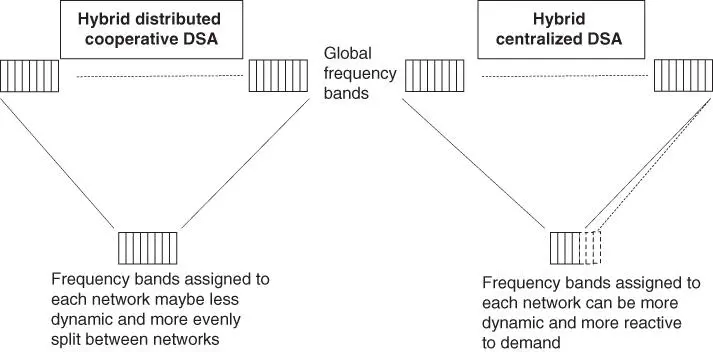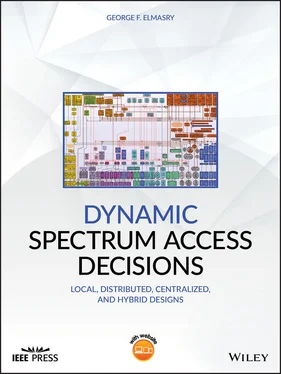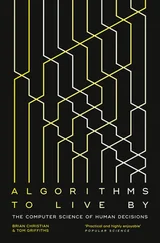4.5 Using a Centralized DSA Arbitrator
Figure 4.8illustrates an example of using a centralized DSA arbitrator with a simplified scenario of three heterogeneous MANETs. The large dashed circles represent a MANET current area of coverage. The small gray circles represent nongateway nodes while the small black circles represent gateway nodes. Gateway nodes are platforms with more than one waveform and are able to be nodes of more than one MANET. The black arrows represent the centralized DSA control plane where the centralized DSA arbitrator sends and receives control traffic to and from the gateway nodes. With this approach, the gateway nodes proxy their respective networks to the centralized DSA arbitrator such that local fusion in the gateway nodes is more comprehensive than fusion in the other network nodes. 14The idea here is to have the gateway nodes send a network‐based spectrum utilization and interference picture to the centralized DSA arbitrator. Although the centralized arbitrator would decide spectrum allocation dynamically between the networks, this allocation is a hybrid allocation that takes into consideration the role of distributed cooperative DSA decisions within each network.

Figure 4.8The use of a centralized DSA arbitrator in a hybrid DSA system of heterogeneous MANETs.
The centralized DSA arbitrator would remove some of the heterogeneous spectrum allocation tasks from a distributed cooperative manner to a centralized manner. This will result in adding a centralized DSA control plane, as illustrated in Figure 4.8, but can drastically reduce the control traffic volume. Here, a gateway node is tasked to obtain the spectrum utilization map of its own network through its own fusion technique, send it to the centralized arbitrator, and proxy the centralized arbitrator's decision only when it cannot reach it. Note that messages sent over the centralized DSA control plane can be multicast messages that reaches the centralized arbitrator and a subset of peer gateway nodes with a single over‐the‐air transmission. This will allow the gateway nodes to rely on the centralized arbitrator for global decision fusion in most cases. In rare cases, when the centralized arbitrator is not reachable for a decision, the gateway node will rely on the distributed cooperative protocol mentioned in the previous section 15to act as a proxy for the centralized arbitrator.
Notice that the way a gateway can proxy a network spectrum utilization can depend on the gateway capabilities. This proxy approach can range from merely consolidating the network sensors' data into one message sent to the centralized arbitrator without fusion at the gateway node to performing extensive fusion at the gateway node and sending the centralized arbitrator a fused spectrum map. Factors such as SWaP limitations at the gateway node can guide the design of the gateway node fusion capabilities.
With this type of hybrid DSA system, we have a mix of centralized spectrum allocation and distributed cooperative spectrum allocation within each network. Each network is assigned a pool of frequency bands to use based on the network's own distributed cooperative protocols while the centralized arbitrator changes the allocation of this pool of frequencies (redistributes frequency pools between all the networks) when its own spectrum map shows the need for such change.
While the distributed cooperative hybrid system can work with a certain number of heterogeneous MANETs, as the number of networks in a large‐scale deployment increases, the need for a centralized arbitrator will increase. Notice that if the design elects that a gateway node would proxy a network spectrum map using extensive fusion, this could reduce the amount of DSA control traffic drastically. The gateway node can abstract the network spectrum map, fusing spectrum sensing information into very compressed messages sent to the centralized arbitrator.
The global spectrum map within the centralized arbitrator has its own advantages. In addition to reducing DSA control traffic volume, the use of a centralized arbitrator can also further optimize spectrum resources allocation. Figure 4.9illustrates how without a centralized arbitrator (left side of the figure), networks can negotiate the division of the global spectrum resources pool in a greedy way, causing spectrum utilization to be less dynamic. 16With the use of a centralized arbitrator (right side of the figure), the spectrum pool can be divided into smaller portions and each network can be assigned a smaller spectrum pool at the start. The spectrum assignment per network can be increased when the network local traffic demand increases and decreased when the network local traffic decreases. However, the centralized arbitrator can mitigate greed based on comparing traffic demand and actual traffic volume from the different networks while considering the global view of spectrum conflicts and interference levels.

Figure 4.9The use of a centralized DSA arbitrator can further optimize spectrum resource allocation between a large‐scale set of heterogeneous networks.
One important advantage of using a centralized DSA arbitrator is the stability of spectrum assignments. The centralized arbitrator can assign each network a set of frequency bands as life lines and this set can be relatively small, as shown on the right of Figure 4.9. The centralized arbitrator can add more frequency band to a network based on traffic demand. The life‐line frequency band assignment can be stable and only changes if mobility requires the redistribution of these life‐line bands. This will create a form of stability in spectrum assignment that will result in creating more stable routes by the distributed cognitive routing engines. One of the challenges facing dynamic resource allocation techniques is rippling, as explained in the previous chapters. Rippling occurs when resources are assigned then quickly taken away to be reassigned. 17This can lead to the establishment and teardown of link before routes are established. The use of a centralized DSA arbitrator offers the designer of these heterogeneous networks the means to reduce rippling.
The use of a centralized arbitrator can also help address energy‐constrained nodes limitations. In heterogeneous MANET, some networks can be sensor networks with limited battery size, with only gateway nodes having enough energy to process high‐volume traffic. The assignment of life‐line frequency bands to energy‐constrained nodes while assigning gateway nodes more frequency bands can result in links between gateway nodes having lower routing cost than that of the links that rely on energy‐constrained nodes, which will decrease the likelihood that an energy‐constrained node is considered for routing higher bandwidth traffic while still maintaining stable network connectivity.
The design of a hybrid DSA system with a centralized arbitrator has to take into consideration the following:
1 There is a place for local DSA decisions, distributed cooperative DSA decisions, and centralized DSA decisions.
2 The speed of these decisions has to be considered in the design where local DSA decisions are fast. Distributed cooperative DSA decisions should take considerably longer than local decisions because they require some knowledge‐based fusion and propagation of fused information between the nodes. Centralized DSA decisions are meant to create stability, including life‐line spectrum allocation, and react to traffic demand increase in more optimum ways than using distributed cooperative decisions for demand‐based resource allocation.
Читать дальше














